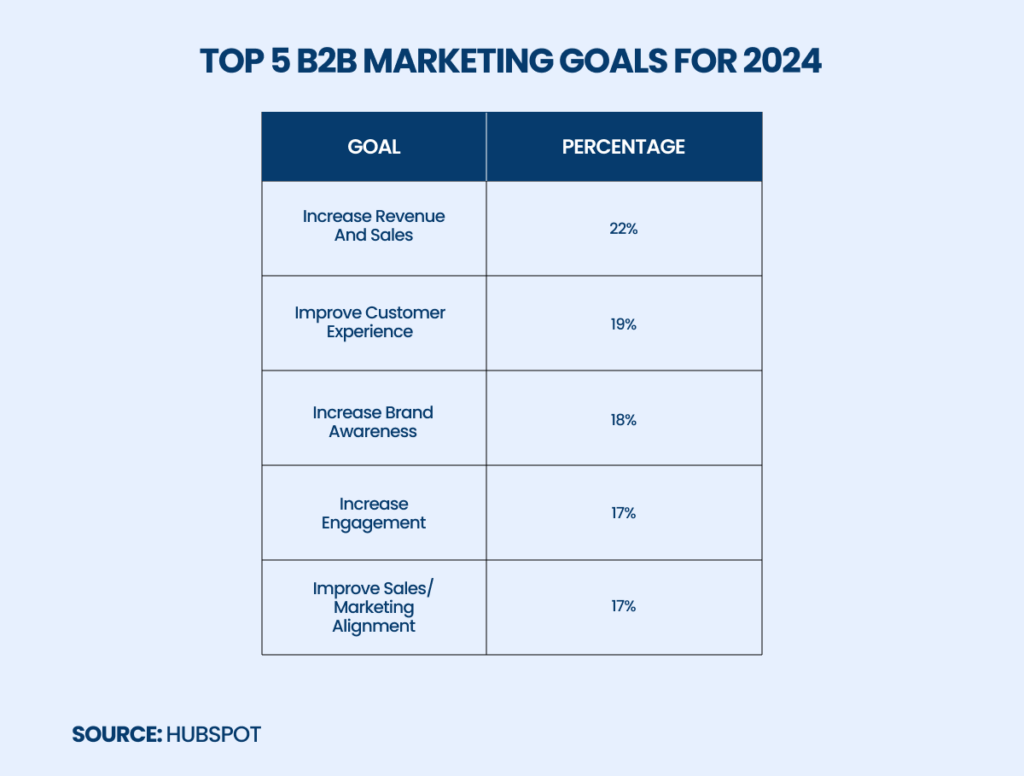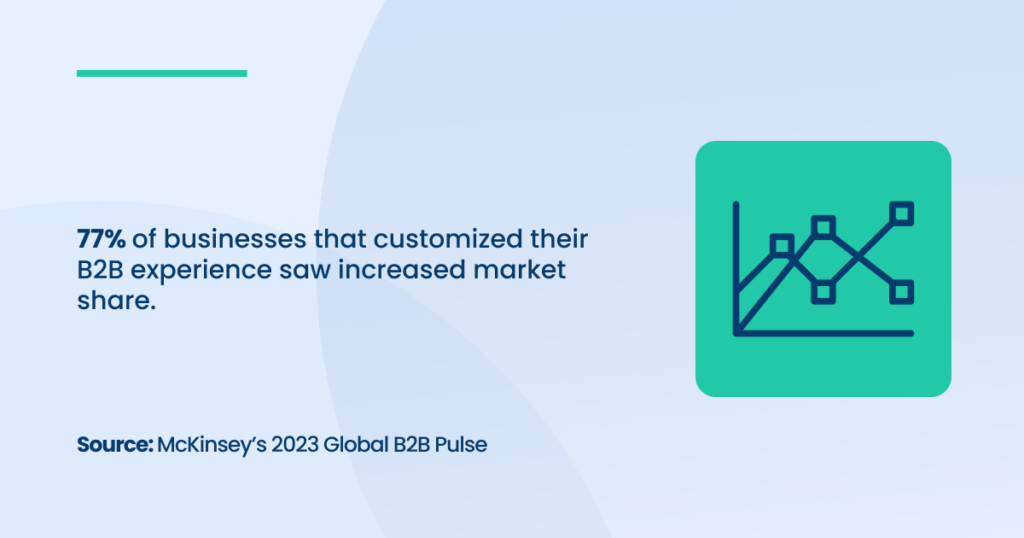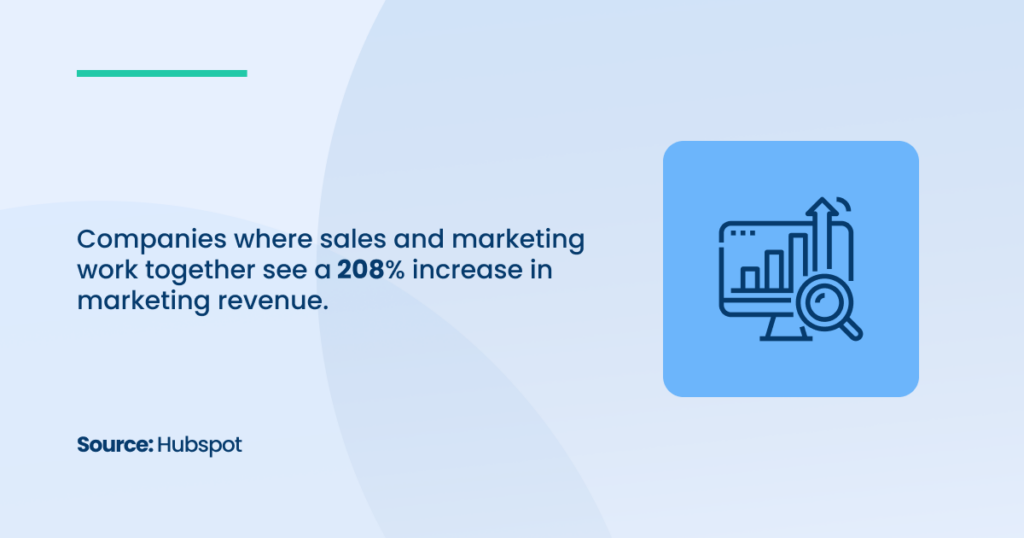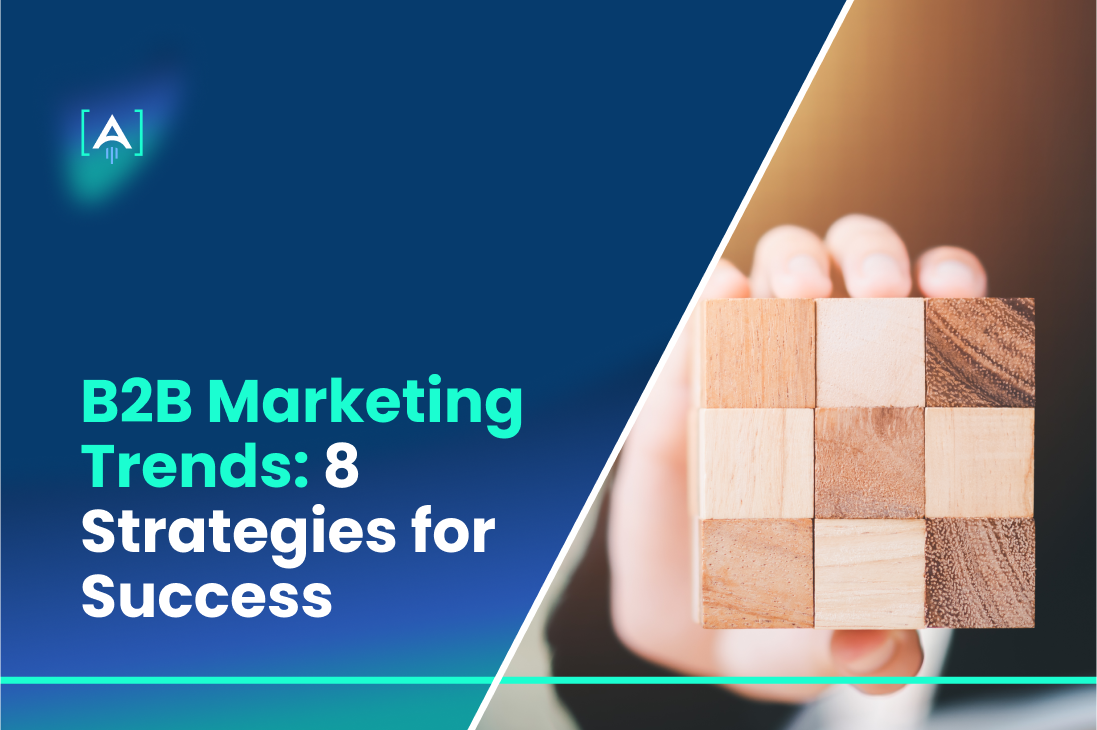Think back to the last time a marketing piece truly caught your attention. It probably wasn’t because it shouted the loudest or followed the latest trend.
It stood out because it felt like it was made for you.
In 2024, B2B marketing trends are all about personal connection and customer-centric marketing, which go beyond surface-level tactics to engage clients in meaningful ways.

Source: HubSpot
As a business leader, your job is to harness these trends in B2B marketing. This article will introduce eight growth marketer-approved trends and strategies that an experienced growth marketing agency uses to help you build stronger relationships, stay competitive, and grow your business.
1. Hyper-Personalization Beyond Email: Customizing the Full Buyer Journey
Today’s B2B buyers expect more than generic emails—they want interactions tailored to their specific needs from the moment they first engage with your brand to the final decision point.
62% of customers say they will leave a business if their experience isn’t personalized, risking their loyalty.
Hyper-personalization takes this a step further by using data to customize the entire buyer journey, making every touchpoint—from your website to follow-up conversations—highly relevant and specific to each client.
This goes beyond addressing them by name; it’s about understanding their unique challenges and offering solutions that directly align with their business goals.

Source: McKinsey’s 2023 Global B2B Pulse
By implementing AI marketing tools and dynamic content, you can create experiences that engage and guide your prospects seamlessly through your conversion funnel, improving conversion rates and fostering long-term loyalty.
2. Account-Based Marketing (ABM) 2.0: Targeting Your Best Clients Across Multiple Channels
Account-based marketing (ABM) involves focusing efforts on your highest-value clients instead of casting a wide net. In 2024, ABM will become even more powerful by using multiple channels to reach these key clients.
Rather than just sending emails, you can engage them through platforms like LinkedIn, personalized websites, direct mail, and more, ensuring your message reaches them wherever they are.
The results speak for themselves—76% of marketers say ABM gets them better results than any other marketing strategy.
Source: Adobe Experience Cloud
By using data to craft the right message and choosing the best platforms to reach your most important clients, you can create personalized, consistent experiences that push them closer to doing business with you.
Plus, with today’s ABM tools, you can track how these clients respond in real time and adjust your approach as needed, ensuring you never miss a chance to close a deal.
Steps to Start ABM Marketing:
- Identify high-value accounts: Focus on clients or prospects that bring the most potential value to your business.
- Research and segment: Gather detailed data on these accounts to understand their specific needs, pain points, and goals.
- Personalize your messaging: Create tailored marketing messages and content that speak directly to each account’s challenges.
- Use multiple channels: Engage them across platforms like LinkedIn, personalized emails, and direct mail to maintain a consistent message.
- Track and optimize: Use ABM tools to monitor engagement and adjust your approach based on real-time data and responses.
3. Thought Leadership and Long-Form Content: Establishing Trust and Authority
B2B buyers want more than just quick information—they want depth and expertise.
Long-form content like whitepapers, in-depth articles, and case studies gives you a chance to provide real value by exploring the problems your audience faces and offering practical solutions.
47% of B2B buyers say that thought leadership helped them discover and eventually purchase from a company not originally seen as a top contender in its industry.
Plus, research shows that longer posts perform better: articles over 3,000 words get 77% more backlinks, while those between 1,000 and 2,000 words receive 56% more social shares on platforms like Facebook, Twitter, and Reddit compared to shorter pieces.
Source: Backlinko
However, thought leadership can lose its impact if it’s too broad, lacks new ideas, or focuses too much on promoting the company rather than helping the audience.
Studies show that 63% of thought leadership content is dismissed for being too generic, 58% for not offering fresh perspectives, and 53% when it comes off as self-promotional.
To avoid this, deliver unique insights and solutions that genuinely help your audience. By consistently publishing thoughtful, detailed content, you’re not just sharing knowledge—you’re positioning your company as a trusted authority, making it more likely that buyers will turn to you when they’re ready to decide.
4. Interactive Content & Virtual Events
The shift towards creating interactive experiences, such as virtual events, quizzes, and polls, is changing how B2B companies engage with potential clients.
Virtual events, in particular, have become essential, allowing companies to offer real-time insights and build relationships with prospects.
A recent study shows that 41% of B2B marketers find virtual events a powerful lead generation tool.
Beyond just holding attention, these formats provide actionable data that can be used to personalize outreach and improve marketing efforts, making every interaction more meaningful and relevant.
Some interactive content types gaining popularity include:
- Live webinars: Offering in-depth learning sessions and product demos.
- Polls and quizzes: Engaging audiences while gathering valuable insights.
- Interactive infographics: Allowing users to explore data and trends visually.
- Virtual workshops: Creating hands-on learning experiences for participants.
- Live Q&A sessions: Providing real-time answers to audience questions.
5. Video Dominance: The Power of Short-Form and Educational Videos
The video has become a significant force in B2B marketing, offering a clear and engaging way to explain complex ideas and highlight products.
Currently, there’s an even bigger focus on short-form and educational videos with a strong hook model—quick, informative content that grabs attention and delivers value fast.
These videos, like product demos, customer testimonials, or explainer clips, are demand-generation tools that help potential clients understand how your solution can help.
Related article: Comparing Growth Marketing and Demand Generation: Which Is Right for Your Business?
Source: HubSpot’s 2023 Social Media Marketing Report
Video works so well because it simplifies information while engaging viewers visually. It’s also highly flexible—you can use it on LinkedIn, YouTube, or even in email campaigns.
Creating short, impactful videos tailored to your audience’s needs can boost engagement, generate more leads, and stand out from the competition.
6. Data-Driven Marketing: Using Real-Time Analytics for Better Decisions
Today, making smart marketing decisions isn’t just about guessing—it’s about using data. In 2024, data-driven marketing will be one of the most valuable B2B marketing trends.
They let B2B companies track their campaigns in real-time, retarget, adjust their retention strategy, and reduce customer churn based on what’s actually working.
Real-time analytics show you what’s successful and what needs improvement so you can quickly tweak your strategies to get better results.
Source: Google
Data helps you make faster, smarter decisions by tracking things like customer behavior on your website, engagement on different platforms, and your return on investment (ROI).
Companies that use data-driven marketing are 23 times more likely to gain new customers and 19 times more likely to be profitable as a result.
Tools like Google Analytics, HubSpot, or Improvado can aggregate all your marketing data and let you monitor key metrics in real time.
For CEOs and business owners, this means you can focus your efforts more effectively, get a higher return on your marketing investment, and quickly adapt when things change in the market.
7. Power of Micro-Influencers: Boosting B2B Results with Targeted Engagement
In B2B marketing, working with micro-influencers—those with 10,000 to 99,999 followers—is proving more effective than partnering with prominent influencers.
61% of B2B marketers see better results with these smaller influencers, compared to just 18% who found success with influencers with over 1 million followers.
With more business happening online, especially since the pandemic, 46% of B2B companies now use influencer marketing. LinkedIn is one of the most common platforms for this, where thought leaders and industry experts are key to building brand trust.
To start a B2B influencer campaign, it’s important to be clear on your product and message, research influencers whose audience fits your business, and build strong relationships with them.
Running multiple posts (not just one) and regularly checking campaign results will help you get the most out of your influencer partnerships.
8. Aligning Sales and Marketing: How Working Together Boosts Success
For many B2B companies, sales and marketing teams often work separately, which can cause problems.
Marketing might bring in leads, but opportunities can be missed if sales don’t know how to handle them properly. In 2024, ensuring sales and marketing work closely together is more important than ever for increasing sales and improving how you connect with customers.
When these two teams are aligned, they send a consistent message to potential clients and create a smoother process, from the first marketing contact to closing the deal.

Source: HubSpot
To make this happen, both teams must have shared goals. For example, marketing needs to understand what kind of leads the sales team can close, while sales should know what content and messaging the marketing team is using to attract those leads. Both teams also need to use the same tools—like a CRM (customer relationship management system)—so everyone can track what’s happening with each lead in real-time.
Here are a few common problems that arise when sales and marketing work separately:
- Poor lead quality: Marketing may pass leads to sales that aren’t ready to buy, wasting time and effort.
- Inconsistent messaging: Sales and marketing may send mixed messages, confusing potential clients.
- Missed opportunities: Without coordination, valuable leads may fall through the cracks, leading to lost sales.
- Lack of data sharing: Important insights from marketing campaigns may not be passed to sales, affecting closing rates.
For business owners or CEOs who are just starting, aligning sales and marketing is more than just following a B2B marketing trend – it means better teamwork and fewer missed opportunities.
It helps you convert more leads into customers, making your business more efficient and driving higher profits.
Boost Your B2B Success with A Growth Agency’s Tailored Solutions
From personalizing the buyer journey to using account-based marketing, interactive content, and video, businesses that embrace these B2B marketing trends will stay competitive and grow in the long run.
Aligning sales and marketing, working with micro-influencers, and using real-time data will help you make smarter choices and build stronger relationships with customers.
Navigating these strategies can be challenging, but having an experienced growth agency that uses a data-driven and ethical approach can be a game-changer for your business, as it can craft strategies that fit your specific business goals.
At Azarian Growth Agency, we help our clients create personalized experiences, improve campaigns in real-time, and ensure sales and marketing teams work seamlessly together.
By partnering with us, you’ll increase revenue, strengthen customer loyalty, and build a more trusted brand.
Ready to grow your business?
Get a Free marketing plan and see how we can accelerate your success in 2024 and beyond!

